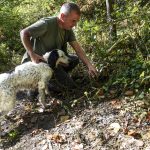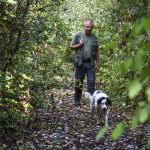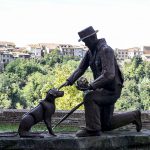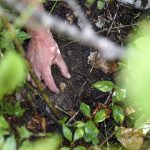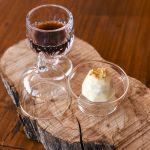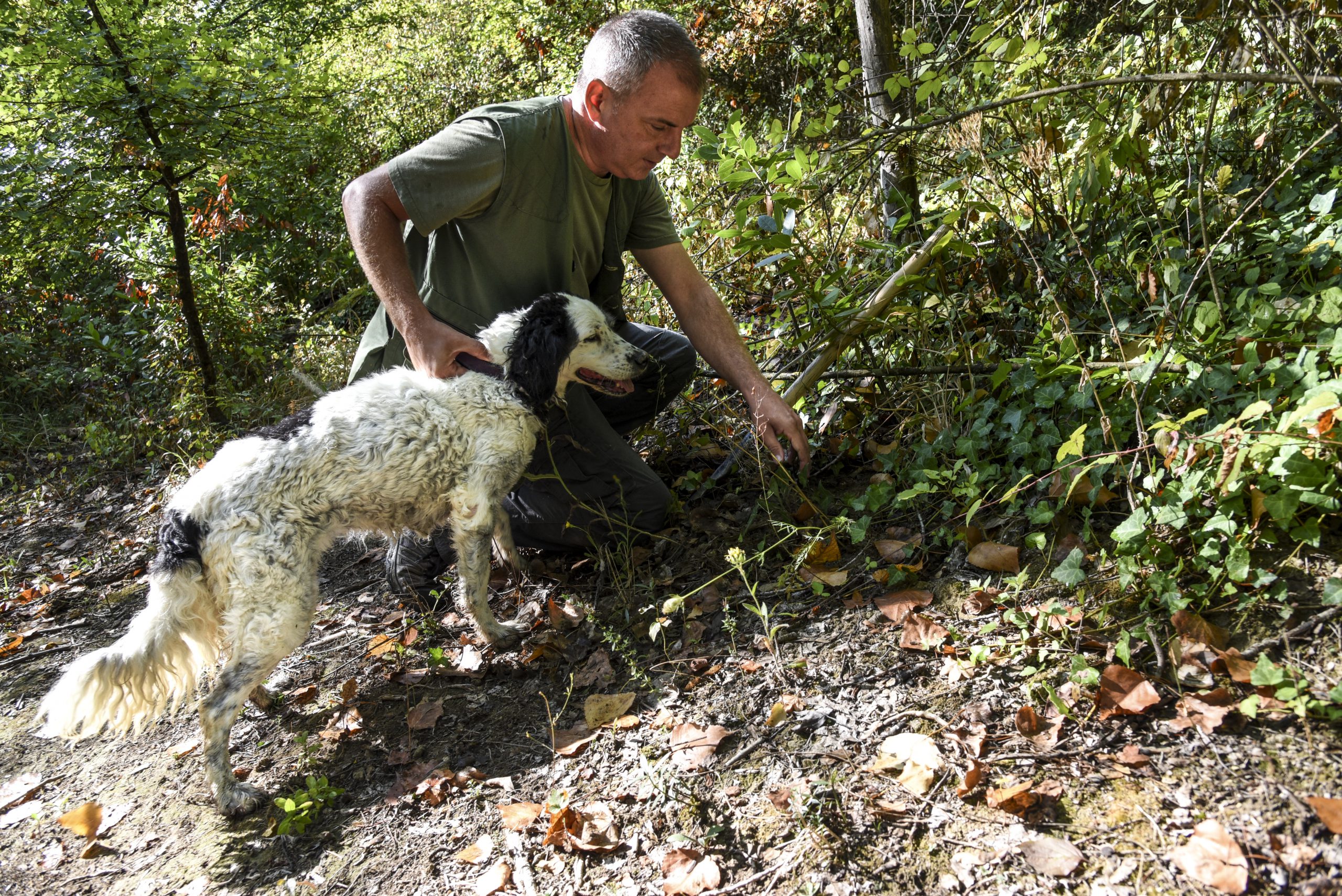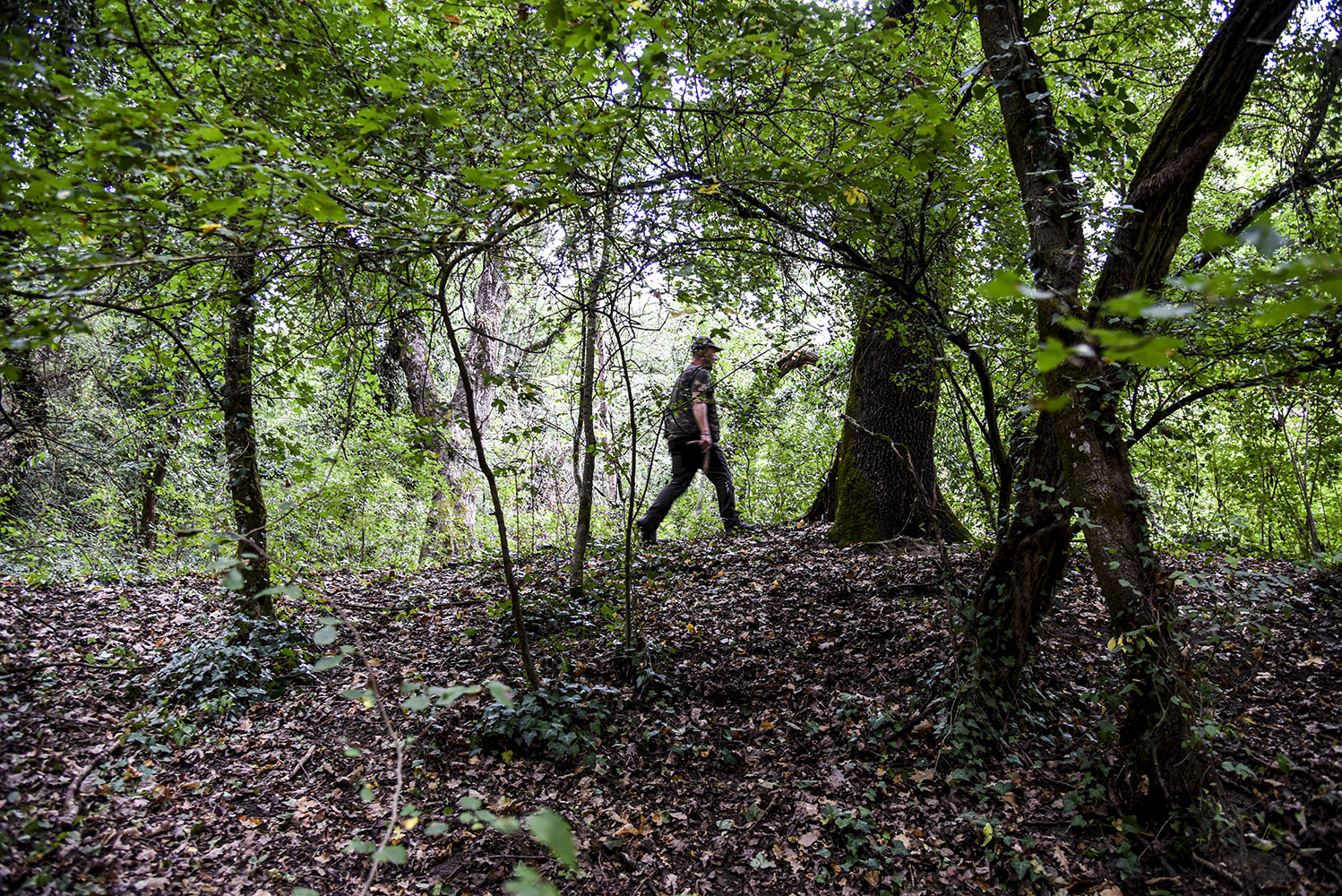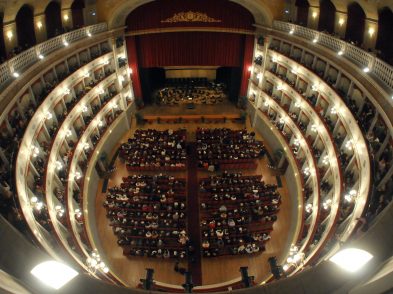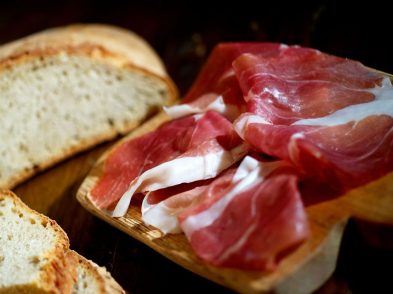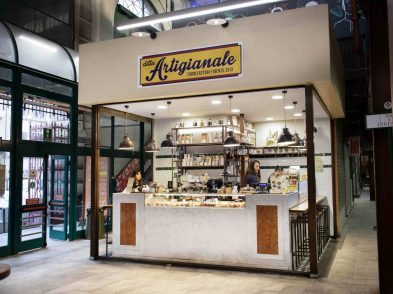- San Miniato
- San Miniato
- San Miniato
- San Miniato
- San Miniato
- San Miniato
- San Miniato
- San Miniato
- San Miniato
- Mugello
- Mugello
- Mugello
- Mugello
- Mugello
- Mugello
- Mugello
“We have truffles all year round in Tuscany,” explains Massimo, as he releases Stella the dog from the spacious pen next to the family home. “But they’re different depending on the season.” The Florentine went truffle hunting in San Miniato and the Mugello on behalf of Toscana Promozione Turistica, Tuscany’s regional tourism board.
San Miniato: embedded beneath the medieval town
There’s healthy rivalry as Stella bounces gleefully towards the sturdy Panda 4×4, the other hounds jostling for attention, wanting to take part in the game at hand. “Stella’s 12, so she’s an experienced dog, although she tires after an hour or so,” explains Massimo, in his khaki country jacket. “Mela’s 4 and Geo’s 6. Then there’s Pepe, who’s 16.” “He’s like a 90 year old,” quips Salvatore, Massimo’s quiet father and something of a legend, it turns out, in the truffle hunting world.
It’s late September as we set out to a tartufaia, the damp ground where truffles grow naturally in a copse of oak, poplar and bloody dogwood trees, embedded with the mineral salts and marine fossils from this land that used to be a sea three million years ago. After being momentarily distracted by the local fauna, probably a rabbit, Stella picks up the scent and she’s off. We circle on and off the path, into the undergrowth and through the woods. The tartufaio guides the dog to the areas where they know the “diamonds of the earth” are likely to be found; after all, these locals know the forests inside out and even keep a diary noting the date, place and weight of their most significant finds. After gentle coaxing—che c’è, Stella? Dov’è? (What’s there? Where is it?)—Stella’s tail starts wagging and she starts moving around a certain patch. Massimo’s immediately on the case, gently moving his canine friend aside to scrape away at the surface with a special wooden-handled spade known as a vanghettino. He sniffs at a handful of dirt before extending it to me. “Smell it, it’s special.” And it is, that ethereal elixir of perfume and earthiness that only truffles have. Massimo digs down, as Stella offers a paw to help, and it’s a black summer truffle, a scorzone or, if you’re getting technical, a tuber aestivum Vitt. Stella’s happy with a biscuit as we delight in the spoils and Massimo carefully fills the hole back in again. “We’re responsible for protecting the habitat. The likelihood is that a truffle will grow in the same spot again next year.”
Stella’s off on the scent again. After an hour in the woods, she’s unearthed two black and two white truffles. “Let’s hope it weighs a kilo!” jokes Salvatore, already happy with the morning’s hoist, as his son dusts off the golden top of the ten-gram perfumed wonder. It’s early for the tuber magnatum Pico, but this one’s a decent specimen, ready for the picking. In fact, if we hadn’t dug it out, the snails and worms would have dined out well.
Salvatore takes the truffle and rubs it on the palm of his hand before raising the tuber to his nose. It’s the procedure to check for veracity. “The perfume increases with heat, but if you’ve been sold a fake, the scent with which it’s been sprayed remains on your hand and there’s nothing on the ‘truffle’. It doesn’t help the first time you buy a truffle from someone, but at least you’ll know who you can trust the next time.”
Salvatore’s as expert as truffle hunters come. He started back in the 1970s when his future father-in-law introduced him to the woods as a way of checking his character. “The first thing he asked was whether I liked to truffle hunt. ‘We’ll go tomorrow!’” Having passed the family test, Salvatore went on to serve as president of the association of truffle hunters in San Miniato for 18 years. “San Miniato is famous for having the biggest, most expensive and most talked-about truffles.”
The biggest one was gifted to US President Eisenhower in 1954, weighing 2,520 grams. Initially claimed to have originally from Alba, Piedmont, a diary entry by truffle hunter Arturo Gallerini helped to prove that the white diamond had been dug out of the earth on October 26, 1954 in San Miniato. The achievement is still celebrated in the Tuscan town today with a wrought iron statue dedicated to Gallerini and his dog Parigi just below piazza Duomo and the Tower of Federico II. The most expensive truffle, an 850-gram specimen from San Miniato, was auctioned to the London restaurant Zafferano for 52,000 dollars, with proceeds going to Meyer pediatric hospital in Florence, in addition to other children’s charities around the world.
Next up are a few tricks in the kitchen as Letizia gently brushes our truffle trove under running water. “It’s important to buy truffles with the dirt still on and to store them wrapped in kitchen paper in a sealed glass or plastic container. Truffles release lots of humidity, so the paper needs to be changed regularly.” With a stainless steel slicer, she explains how the grain inside the tuber shows the quality, season and type. Black truffles range from light to dark brown, while the white variety is pinkish inside. What’s most important is the veining, the marble effect that testifies to a real truffle. As Letizia slices the truffles, the perfume drifts immediately into the ether, entwining with our senses. “White truffles are more pungent and persistent; you really experience them at the front of your mouth.”
White truffles can’t stand the heat, whereas black ones are slightly hardier and can withstand temperatures up to 70°C. White truffles are so perfumed that the pairings are few: eggs (including fresh pasta), young cheeses, butter, potatoes, cabbage and cauliflower, even white chocolate. Black ones are more adaptable and offer more fun on the culinary front as Letizia cooks up a feast for lunch: chickpea puree topped with black truffle shavings; burrata ravioli with salted butter, hazelnuts, thyme and six drops of colatura di alici, an anchovy condiment, with wafer-thin slices of black summer truffle; potato soufflé, poached egg, taleggio sauce and white truffles, whose scent release endorphins with their female chromosomes that widen the eyes. Finishing with a white truffle chocolate truffle and a glass of homemade nocino, a walnut liqueur, we are presented with certificates as ambassadors of real Tuscan truffles, in a commitment to promote and protect the culture of these diamonds of the earth.
Mugello: a walk on the wild side
“I feel like I’m in Rambo,” shrieks our photographer as he slides down one bank, over the stream and climbs up the other side. Massimo the tartufaio is clad head to foot in camouflage as we venture deeper into the thicket. There’s a sort of path, but Lagotto mother and son dogs, Birbe, 3, and Stella, 11, much prefer the forest floor as we weave our way over fallen logs and through prickly hedgerows. It’s not for the faint-hearted, but the experience is authentic and primeval. On a brook bank, the hounds are wagging their tails. They believe they’ve hit white gold, but it’s early in the season. “Something all you need a crumb like this and my babies will sniff them out.” Massimo opens his hand to reveal a fleck of truffle and smells the perfumed earth. Would the dogs tuck into the delicacy if left to their own devices?, I ask. “If I’m close, they won’t eat them, but otherwise they will.”
In the Mugello, the truffle season runs from mid October to late November as the tubers grow at an altitude between 300 to 450 metres. While truffles can even be found in open fields, there are reserved sections marked by signs permitted by the local council, protected by the local association of truffle hunters. In Tuscany, anyone can apply for a five-year licence as long as they pass an examination, which focuses on recognizing truffle types, hunting techniques, knowledge of the national and regional legislation, and ways to protect the environment in which truffles grow.
“Show me where it is, Birbe,” cajoles Massimo. We’re in a beautiful little glade, somewhere not far from the Giotto house museum, with ivy-wound trunks all around, twigs underfoot, and the leaves display their early autumn colours: yellow, green and brown. In the distance, a gunshot rings out, a reminder of the other hunting in the Mugello for wild boar, deer and other game. Our intrepid leaders are undeterred, accustomed as they are to the sounds of the forest where they work and play.
Massimo prises a white truffle from the damp earth, the dogs are content and we breathe in the hedonistic aromas. Chef Cristian, who’s a local in these woods and has joined us for the adventure, muses over the simple dishes he’ll make in his Vicchio kitchen. “We have a modern but local menu that changes with the season: fried eggs or fresh egg tagliatelle and tagliolini with white truffles shaved over the top; hand-chopped beef tartare with black truffles. The leaves are turning after an end-of-summer downpour as the sun casts its rays through the clouds as we emerge from the forest into a rolling field of clods of earth so typical of this fruitful corner of Tuscany: the Mugello.
The truffle calendar
Truffles grow spontaneously and naturally throughout the seasons in Tuscany in six areas: Mugello, San Miniato, Valtiberina, Crete Senesi, Casentino and Maremma Grossetana. The marzuolo (spring truffle) can be found between January and April; the summer black truffle (or scorzone) between June and November; and the prized white truffle from late September to December. Truffles should be dug out of the ground when they’re ready; if not, they should be left alone. The black truffle is hardy and stays fresh for around 40 days; the white for 25 days, whereas the marzuolo stays good to eat for up to 10 days.
With thanks to Massimo, Salvatore and Letizia Cucchiara of Truffle in Tuscany in San Miniato and chef Cristian Borchi and tartufaio Massimo Poggiali in Vicchio, Mugello for the making of the article.

